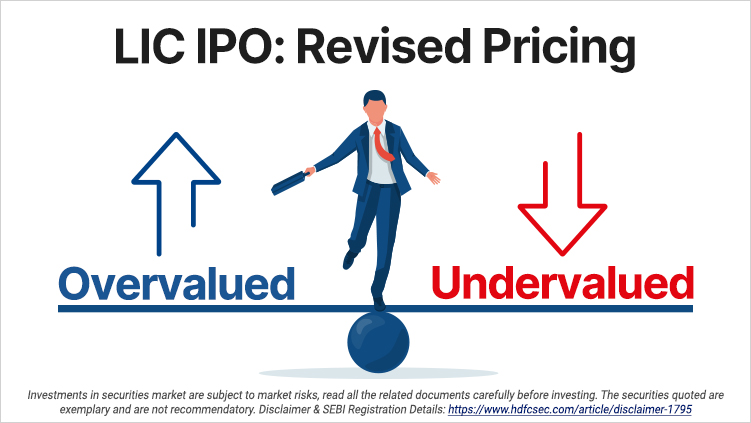LIC IPO: After Revised Pricing, Is it Undervalued or Overvalued?
The largest IPO in India's history is all set to open on May 4, 2022. This is despite the trimming down of the issue size from 5% of the equity to 3.5%. On April 27, the Life Corporation of India (LIC) revised the price band for its IPO to ₹902-₹904. This makes the shares the most valuable to be issued in recent times. In fact, it is not just more valuable than its insurance sector counterparts but also the likes of IRCTC, Dixon Tech and Adani Wilmar. With this, LIC IPO will become the most expensive public sector company.
On the other hand, the company is valued at ₹6 lakh crore, and for decades now, LIC has dominated the insurance market in India. So, with the revised pricing, is the IPO undervalued or overvalued? Let's take a look at some factors that can help determine this.
Embedded Value
If we take a look at how LIC’s peers are faring, we find that HDFC Life trades at around 4x its embedded value (EV), while SBI Life and ICICI Prudential Life have a valuation of about 3x-2.5x their respective EVs. Now, if LIC were to be viewed with the same valuation as its peers, i.e., at 4x its EV, it would have a market cap of ₹16 lakh crores to ₹21.58 lakh crores. Even with the lower multiple of 2-2.5x, its valuation would come to ₹13 lakh crores.
However, LIC’s market cap was revised down to ₹6 lakh crores due to the ongoing global economic situation, while also taking into account the market and liquidity conditions. At this market cap, the current issue price works out to 1.1x, which is much lower than both its Indian and global peers. At this multiple, the IPO certainly appears to be a good opportunity for investors to own a piece of a seemingly lucrative pie.
Share of Participating Policies
COVID-related fears drove insurance penetration from 2.82% in 2019 to 3.2% in 2020, closing the gap with the global average of 3.3%, as of 2021. Although the investment ethos in India has seen a sea change since the onset of the pandemic, a major portion of the business for the insurance sector comes from protection and non-participating plans. This is because participating plans tend to generate variable returns, as compared to the guarantees that non-participating products come with.
Things are a little different for LIC. A major portion of its new business premiums is generated by participating plans. The problem here is that these plans tend to be lower margin than their non-participating counterparts.
So, it is important to check the type of insurance the company is underwriting before making an investment decision. Of course, LIC has expressed its intent to focus more on non-participating products going forward, which are higher margin and give insurance companies a higher valuation.
Single-Premium Policies Abound
The biggest advantage of regular premiums for an insurance company is that it locks the customer in for 20-30 years. Unfortunately, with LIC’s Red Herring Prospectus, over 82% of its New Business Premium (NBP) came from single premium products in FY2021. In fact, the share of single premium products in its total NBP has been rising, given that it stood at 78% in FY2019.
The question now is whether LIC can and is willing to bring about a shift in this to regular premium payments.
Value of New Business
Another ratio to consider is the Value of New Business (VNB), since it indicates an insurance company’s profit margins. VNB is determined by dividing the total value of an insurance firm’s new business by its annualized premium for the year. So, high VNB means higher profitability. For LIC, the VNB stood at 9.3% for the 6 months ended September 30, 2021, as compared to 27.1% for ICICI Prudential Life, 26.5% for HDFC Life, and 21.9% for SBI Life.
Market Share
Private sector insurance firms have been on the rise in recent times. Between FY2016 and FY2021, the total premium for private sector life insurance players rose at a CAGR of 18%, compared to LIC’s 9%. So, a key concern here is that LIC is losing market share to private insurance firms. LIC’s market share has been declining over the past three years, falling from 66.4% in 2019 to 61.6% in 2021.
Conclusion
On the whole, given the size and dominance of LIC in the Indian insurance market, the IPO does seem reasonably priced. However, what investors will need to focus on now are the company's future prospects, especially growth in the right direction, given all the factors taken into account above to determine its value as an investment option.
Related Posts
Don't miss another Article
Subscribe to our blog for free and get regular updates right into your inbox.
Categories
newsletter
 HSL Mobile App
HSL Mobile App 



